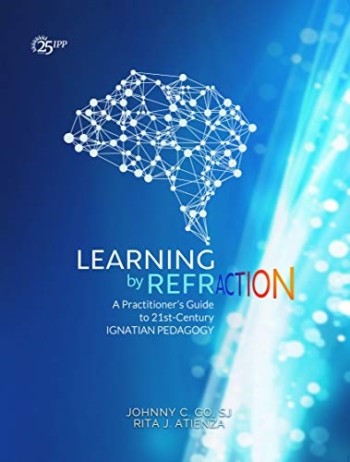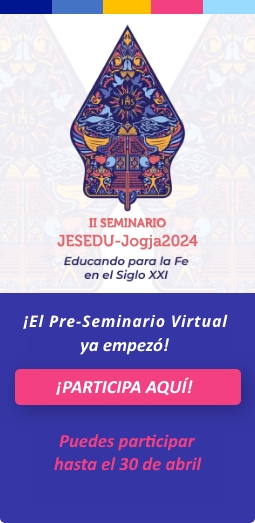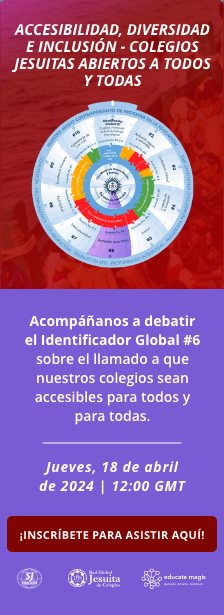Rita Atienza, co-author of the book Learning by Refraction, shares what it was like to write about preparing today’s generation for the future, the Ignatian way.
 This book, Learning by Refraction: A Practitioner’s Guide to 21st Century Ignatian Pedagogy by Fr. Johnny C. Go, SJ and I, means a lot to me. First, I am blessed and very grateful to have been invited by Fr. Johnny to write this book with him, as well as to be a part of the SALT (Science and Art of Learning and Teaching Institute) team. He has been both leader and mentor and I have witnessed his efforts to push this conversation forward as he continues to find synergies among the teacher training initiatives in the Loyola Schools and to find and leverage intersections of SALT and the Jesuit Basic Education Commission (JBEC), the Jesuit Asia-Pacific Conference (JCAP), and other Jesuit institutions across the globe. It is in fact thanks to the wonder of the internet, Viber, and Google Docs that we were even able to carry on the back-and-forth that was necessary to flesh out the ideas in the book since Fr. Johnny’s work involves constantly traveling across the Asia Pacific region and beyond!
This book, Learning by Refraction: A Practitioner’s Guide to 21st Century Ignatian Pedagogy by Fr. Johnny C. Go, SJ and I, means a lot to me. First, I am blessed and very grateful to have been invited by Fr. Johnny to write this book with him, as well as to be a part of the SALT (Science and Art of Learning and Teaching Institute) team. He has been both leader and mentor and I have witnessed his efforts to push this conversation forward as he continues to find synergies among the teacher training initiatives in the Loyola Schools and to find and leverage intersections of SALT and the Jesuit Basic Education Commission (JBEC), the Jesuit Asia-Pacific Conference (JCAP), and other Jesuit institutions across the globe. It is in fact thanks to the wonder of the internet, Viber, and Google Docs that we were even able to carry on the back-and-forth that was necessary to flesh out the ideas in the book since Fr. Johnny’s work involves constantly traveling across the Asia Pacific region and beyond!
Second, I have always loved learning about new things. When I was growing up, birthday or Christmas gifts or rewards for good grades meant going to a bookstore and selecting one book to bring home! Growing up conjures memories of being invited to sit next to my father who had just received a new book from the Book of the Month Club, so he could sniff the ink with delight, turn each page with great care, and excitedly tell me what the book was about. I would hear more bits and pieces of it at the dinner table over the next few weeks. Eventually, I came to realize that true meaning, engagement, and learning only comes about if students are given opportunities to be active participants in an ongoing conversation (that is, a collegial inquiry and analysis) into the subject matter and if the teacher designs experiences that give the subject matter depth and dimension. This book starts a conversation among educators about how this can be done.
All committed educators today must reflect on what kind of education will prepare today’s Gen Z and Gen Alpha generation of learners for the unknown future that awaits them. In our recently-released book Learning by Refraction: A Practitioner’s Guide to 21st Century Ignatian Pedagogy, Fr. Johnny C. Go, SJ and I address all educators—from Jesuit and non-Jesuit schools alike—who are ready and willing to tackle this question. We point out how the central tenets of Ignatian Pedagogy in fact provide a “way of proceeding” for effectively preparing students for a future world in which mastery of discrete knowledge and skills alone—all of which are now easily available online when and where these are needed—are not enough preparation for graduates to deal with the complex and perhaps even existential problems and situations they will have to solve in their lifetime.
This book builds on the legacies of renowned Jesuit educators all over the world who have inquired extensively into how they can make the principles of Jesuit education more usable for teachers. In fact, one of the contributions of Jesuits to education that I find particularly striking is that, as far back as 400 years ago, Jesuit educators institutionalized and systematized, then later formally documented and codified, their philosophy of education, pedagogy, and administrative practices. To me, this speaks of an intention and singular-minded focus on ensuring that the Jesuit goals of education are achieved for their growing system of schools all over the world. I find this truly remarkable because even today, this deliberate and purposeful design that goes beyond just beautifully worded Vision, Mission, and Goals in the handbook and action plans on paper, is what I find to be sorely lacking in many schools around the country today. This also ensures the use of a common vocabulary and language that each member of the Jesuit school communities understands in the same way, and a strong uniquely-Jesuit classroom and school culture that the growing network of Jesuit educators and schools are encouraged to discuss and continue building together.
I think this openness and responsiveness to the needs of the times, this encouragement of any contribution to enrich the Jesuit system of education is what allows it remain relevant and responsive to any place, age, and circumstances (because God is, after all, found in all things and all times). I hope that Learning by Refraction builds on this legacy by proposing current research and best practice, new frameworks, new vocabulary to further enrich the elements of Ignatian pedagogy and its practice.
To order the book please follow these links:
Ateneo de Manila University Press: Learning by Refraction: A Practitioner’s Guide to 21st-Century Ignatian Pedagogy
Amazon: Learning by Refraction: A Practitioner’s Guide to 21st-Century Ignatian Pedagogy – Kindle Edition
Inicia sesión o Hazte miembro
para crear y ver comentarios

